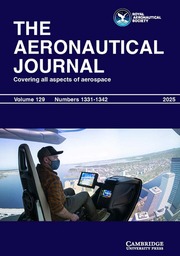No CrossRef data available.
Article contents
Operational safety and unmanned aircraft: Hazards related to air traffic control activity
Published online by Cambridge University Press: 17 October 2025
Abstract
The increase in activities related to unmanned aircraft systems and the implementation of this new ecosystem have introduced new hazards, impacting the operational safety of air traffic, particularly near airports, creating risks and disruptions in the flow of aircraft. The establishment of airspace for unmanned traffic management has required the integration of this new airspace with the existing one, bringing the potential for issues from this integration. A method was identified as needed to guide the detection of hazards posed to air traffic control activities and the consequent implementation of required mitigation measures. The aim of this work is to propose a framework for identifying hazards introduced to air traffic control, with a view to ensure the safe transition of this process. The method involved consulting air traffic operational safety specialists via a questionnaire, presenting the hazards highlighted in the literature concerning the integration of new airspace concepts within air traffic control activities. The results, obtained through a Delphi consultation, were analysed based on the most frequently assigned scores (mode) to reflect expert consensus. The results were organised into the proposed framework, establishing a guide to risk management activities aimed at implementing the change. The resulting structure was re-submitted to specialists and validated based on the Delphi method. Contributions to society include a guide for this process and potential future implementations, while the literature gap was addressed by adding knowledge to the scientific process.
Keywords
Information
- Type
- Research Article
- Information
- Copyright
- © The Author(s), 2025. Published by Cambridge University Press on behalf of Royal Aeronautical Society


